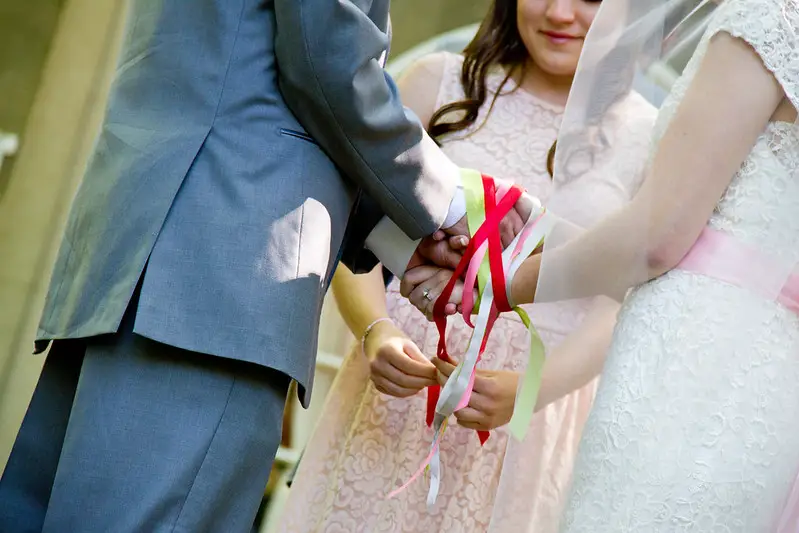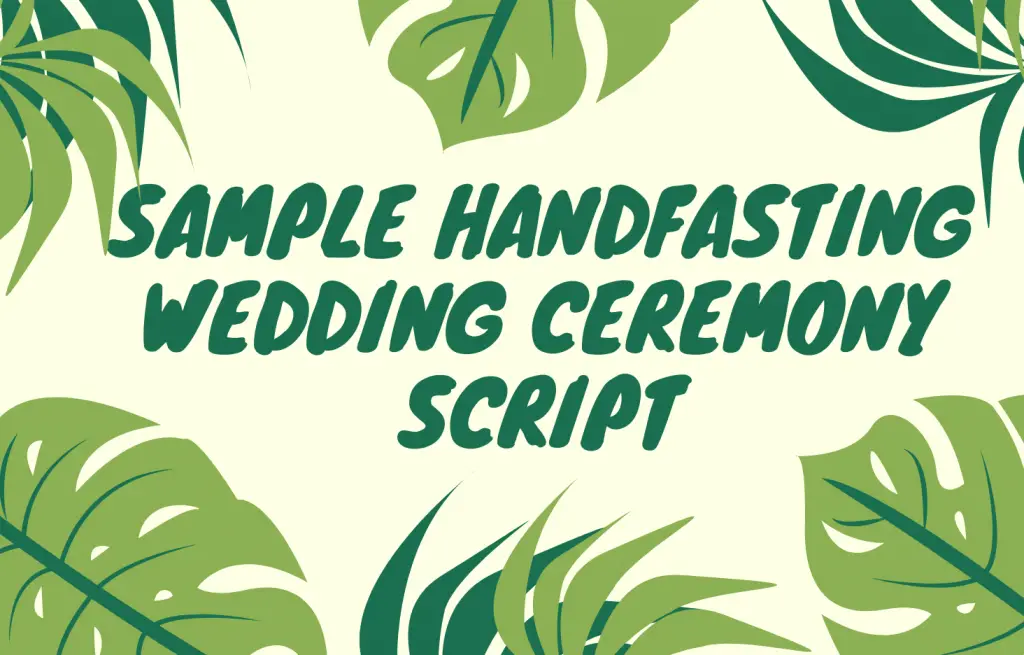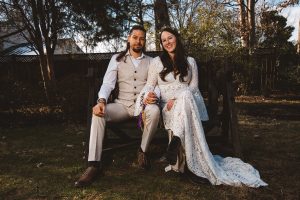Many couples wish to incorporate a handfasting ceremony into their weddings and there are plenty of different ways to do this. In this post, I’ll break down all of the details about handfasting wedding ceremonies so that you can easily do your own unique version at your wedding!
For a handfasting ceremony, you’ll just need hands, your voices, and of course, cords (or ribbons)! You can check prices of Celtic handfasting cords with charms on Amazon here.
For my readers: If you have any questions about handfastings or wedding ceremonies, please email me (brittany@wayfaringweddings.com) — I’m a real person behind this blog 🙂 and I also have a wedding YouTube channel you can find and message me at here! Here’s my video on Handfasting wedding ceremonies you should check out:
This 10-Part Post Will Cover:
- A Sample Full Script for a Handfasting Wedding Ceremony
- What is a Handfasting Ceremony and Why Do It?
- Preparation for Before Your Handfasting Ceremony
- Preparing What to Say at a Handfasting Ceremony: The Script and Vows
- Combining a Handfasting Ceremony with a Ring Exchange
- Watch a Real Scottish Handfasting Take Place Before Your Ceremony
- How to Tie the Handfasting Cords
- Is a Handfasting Ceremony a Legal Marriage?
- History of Handfasting Wedding Ceremonies
- Renewing Vows with a Handfasting Ceremony
If you just want a simple “Celebration of the Hands”…
Please note that if you’re just looking for a simple “celebration of the hands” script, which is a quick blessing of the couple’s clasped hands before the exchange of vows and rings (and can include a ribbon/cord or nothing at all), then you probably don’t need this complete 10-step guide to a handfasting. You can simply ask your officiant to say the following words, and insert them into your ceremony script:
“Before exchanging rings, please join your hands and with your hands your hearts.
[The couple joins their hands, ideally their right hands together and left hands together, forming a figure-eight, or an infinity symbol, when viewed from the top. The officiant continues…]
These are the hands of your best friend, young and strong and full of love for you, that are holding yours on your wedding day, as you promise to love each other today, tomorrow, and forever. These are the hands that will work alongside yours, as together you build your future.
These are the hands that will passionately love you and cherish you through the years, and with the slightest touch, will comfort you like no other. These are the hands that will hold you when fear or grief fills your mind. These are the hands that will countless times wipe the tears from your eyes; tears of sorrow, and as in today, tears of joy.
These are the hands that will tenderly hold your children, the hands that will help you to hold your family as one. These are the hands that will give you strength when you need it. And lastly, these are the hands that even when wrinkled and aged, will still be reaching for yours, still giving you the same unspoken tenderness with just a touch.”
If you WOULD like to take this wedding ritual a step further, to join hands and have them “fasted” by your officiant in a ceremonial fashion, then please read on 🙂
Welcome to the Complete 10-Step Guide to Having a Handfasting Wedding Ceremony!
A handfasting ceremony can either be the main event of your wedding, or it can be an element that you incorporate into the ceremony to accompany other traditions, such as a ring exchange. This is what we’re planning on doing for our own wedding, based on other models we’ve seen.
You can choose to have a full Pagan or Wiccan ceremony, or you can bring the handfasting into your non-religious or Christian wedding ceremonies. The beauty of this tradition is that it has been altered and reformulated over many centuries, and in many different cultures. It’s a beautiful ritual that is meant to be adapted and shaped to the wants of the couple getting married — making it the best, most personal ceremony for a wedding!
#1: A Sample Full Script PDF for a Handfasting Wedding Ceremony (Non-religious)
Click the image above or here for a free downloadable sample PDF handfasting wedding script (non-religious) that you can use for your own wedding! It’s a 4-page fill-in-the-blank script that is simple and easy to use.
This is a script that I have personally adapted from my friends and family members’ wedding scripts (especially my brother’s wedding ceremony), and also from handfasting books cited at the end of this post.
You can definitely adapt it even more to suit your own wedding! Don’t feel obliged to follow the script exactly as it is. It’s non-religious but spiritual (somewhat humanist I guess) and can be joined with a religious ceremony, or adapted to be more of a traditional Pagan ceremony. There are also more sample handfasting texts and vows in Step #4 of this post!
In this script, you’ll find the following handfasting wedding ceremony elements, which can be moved around or altered to fit exactly how you envision your wedding:
- Processional and music
- Welcome & Opening Remarks/Statement of Intention
- First Reading
- Second Reading
- Presentation of the handfasting cords or ribbons
- Handfasting ritual and ‘Celebration of the Hands’
- Exchange of Vows
- Declaration of Marriage
- Closing
- Recessional and music
In the script, the officiant says the meanings of the colors of the cords/ribbons— why the couple chose these colors and what they represent. Look at Part #3 of this guide to see what all of the different color cords represent!
This script also includes vows for the couple to simply respond to– it’s made very easy for you if you don’t want the pressure of writing and speaking your own vows. If the couple wants to write their own vows, however, they can definitely tweak the script to accommodate that!
#2: What is a Handfasting Wedding Ceremony?
A wedding handfasting ceremony is when the couple combines their hands, traditionally right hand to right hand and left hand to left hand in a figure-eight, and the officiant joins them together with a ceremonial ribbon, thereby “tying the knot” and joining them in marriage.
The Middle English Dictionary defines a handfasting as “to betroth two people, unite, pledge oneself to.”
There are many variations on this ritual, including clasping just one hand together, or using cords instead of ribbons.
The phrase “tying the knot” actually comes from traditional wedding handfasting rituals, wherein the officiant ties a knot over the hands, joining the couple in marriage. As the officiant ties them together, beautiful words are spoken making them “one.” Afterward, the couple can slip their hands out of the knot (they should never untie it) and keep the ribbons in a safe place in their home.
Handfasting was done traditionally in the British Isles before weddings were officiated by any church. Couples would simply stand in front of an officiant and a witness or two, say their solemn vows with a bit a cloth joining their hands, and that would be that. We actually see this sort of scene play out in the enchanted forest wedding in the movie Braveheart:
Why Have a Handfasting at Your Wedding?
Handfasting ceremonies are a traditional and optically beautiful ritual, that can also allow some couples to connect with their Celtic or Viking roots. Some couples are even traveling abroad to Scotland or Ireland to have their handfasting wedding rituals performed.
You should have a handfasting ceremony if you’re curious to connect to your cultural roots, interested in incorporating it just because you like the symbolism of bringing together two people in this intimate way in front of an audience (much more intimate than a simple ring exchange, in my opinion), or just because you want something different from the average wedding you’ve seen again and again.
Handfastings have also become more and more popular as they’ve been shown in several popular movies and TV series such as Outlander:
And remember that a handfasting does not have to be religious or Pagan unless you want it to be. It can be incorporated into a secular or a Christian wedding ceremony as well.
There was a brief moment during the 2011 royal wedding of William and Kate where the Archbishop draped a piece of cloth over the couple’s hands. Although not exactly a handfasting, it was a moment that did drawn on this ancient ritual. And all this happened, despite the fact that the royal wedding was a very religious, Church of England (Protestant Anglican) ceremony:
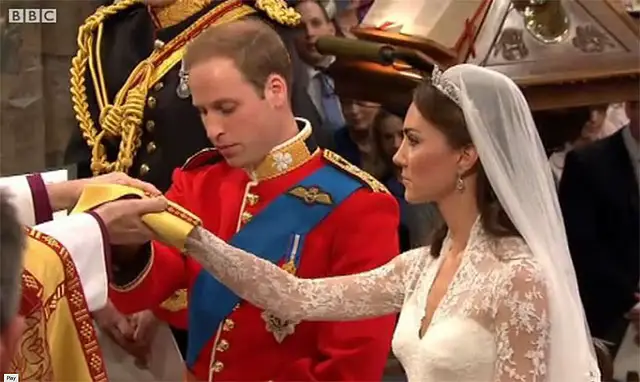
As you decide whether or not to do a full-on handfasting ceremony in the traditional Pagan style, or to simply include elements of a handfasting into your secular, humanist, or another-kind-of-religious wedding, close your eyes and imagine yourself on your wedding day. How do you want it to be? What feeling do you want it to have?
If you can see you and your partner engaged in this ritual, I say go for it!
#3: Details to Prepare Before Your Handfasting
Just like any other type of wedding, or part of your wedding ceremony, you have to plan ahead for a handfasting. It’s not something you should just “wing” as there are some important logistics involved! You know, all those cords, and hands, and which words to say and all that good stuff!
You want your officiant to be comfortable with every part of it, and to know the correct way to tie the ribbons and exactly what to say.
You should plan every detail down to having the microphone stand prepared. You don’t want your poor officiant to be trying to juggle the microphone, their ceremony script, AND tie your handfasting ribbons! It could get a little awkward…
Read on to learn about the things you need to do BEFORE your ceremony…
How many cords are in a handfasting ceremony?
A common number of cords to use for a handfasting ceremony is three, because it allows the couple have a cord each to represent their two families, plus one cord to represent their new life together.
Traditional numbers for cords/ribbons is to use 1, 3, or 6.
However, there is no rule on the number of cords to use, and it’s really up to you. There have been couples who use one cord or ribbon, and others who positively mummify their hands together with layers of fabric! I don’t really recommend that, but it’s up to you! Think about the look that you want your handfasting to have and consider using between 1-6 of the following:
- Ceremonial cords or rope
- Ribbons
- Long fabric swatches of the bride’s dress
- Recycled fabric swatches from a family member that are meaningful
- A swatch of family tartan if you’re of Scottish heritage
- A long piece of lace
If you do choose to use three cords/ribbons, each partner should choose one color to represent each of their families. And then the couple should choose one color for the third cord to represent their new lives together.
How long should your handfasting cords be?
Your handfasting cords should be at least a meter long each and no more than two meters long, allowing for enough room to tie the knot, but not so long that they’re burdensome. The optics of having nice, long cords is a really beautiful affect, in my opinion. You’ll see a video in Step #7 that shows how to tie the infinity knot.
How should you choose the colors of the handfasting cords?
There’s a part of the sample script in Step #1 where the cords are presented by your family members, one cord from each family. It’s a great opportunity to include a special family member in your handfasting ceremony as a representative!
In the script, the meaning of the color is also expressed. In the script, the officiant says something like this:
I will now ask [FAMILY MEMBER’S NAME___________] to present the first
cord representing ‘s side of the family. The color_____________ was chosen
by the couple to represent_____________ in their marriage together.
And you can fill in the blanks! You can choose colors for your cords/ribbons that you like or that have a particular meaning for you. Consider school colors, flag colors, or any other symbolic colors that might be special to you. Or, you can take a look at some traditional meanings of colors below and choose one:
Green: Symbolizes wealth, new beginnings, spring time, the earth, and fertility.
Pink: Symbolizes spontaneity, romance, and childlike wonder.
Red: Symbolizes passion.
Purple: Symbolizes royalty, creativity, and devotion.
Yellow: Symbolizes energy and optimism.
Blue: Symbolizes depth, stability, and trust.
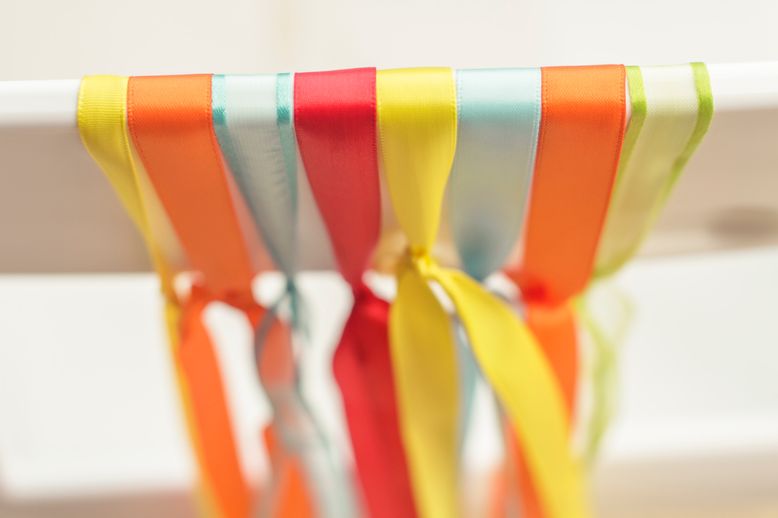
Can Anyone Perform a Handfasting Ceremony?
If you’re having a handfasting wedding ceremony and don’t mind whether or not it’s going to be legally binding, then anyone can perform it. However, if you want your handfasting ceremony to act as a legal wedding, then the person who’s performing it must be legally recognized as clergy in your jurisdiction.
Even then, some areas will not accept handfasting as a legally binding ceremony, and couples who would like to do this will have to find an officiant who can do both a handfasting AND go through the actions and words of a legal ceremony.
Do some research about your area at least a few months before your wedding to find out what the laws are, so you have enough time to find the perfect officiant!
What should you wear to a handfasting ceremony?
The couple can wear whatever they want and what they would wear to any other wedding ceremony. Some couples choose to wear more traditional Scottish garb, or Pagan robes, or to include some nods to nature in their looks (flower crowns for example), but there are no rules. Wear whatever you’d like!
Guests can also wear what they would normally wear to any other wedding. If it’s a Pagan or Wiccan handfasting ceremony, there may be an indication of the dress code on the invitation!
#4: Preparing What to Say at a Handfasting Ceremony (With Samples)
Now, what should you say and what should your officiant say while binding your hands at the wedding? There are many options. The officiant can say the “Celebration of the Hands” mentioned at the beginning of this post, which is very beautiful and powerful.
The officiant can say something that you personally write about the importance of joining two lives and two families together. Or you can use a sample script, such as the one I linked above in Step #1.
Here is another sample of text that you could use in your ceremony script. As the officiant blesses your hands, they would say:
“Nature finds no greater pleasure than a couple’s loving union. The joining of hearts, bodies, minds, and souls is a celebration of the path Nature has set us upon. With this handfasting, ___________ and _________ are bound together for life’s seasons of love.
In the spring of their love, they will explore each other.Their senses will bud with the newness and potential of their match. By the midsummer of their love, full-blossomed devotion will offer a rich harvest — children, prosperity, challenges, and rewards. The autumn of love promises the harvest of dearest friendship and mature passion.
And finally, when the pure snows of winter blanket the earth of their lives, ______________ and ______________ will rejoice at the lifetime of love they have shared and be warmed by the deep bond made here today, which still holds them. Today we rejoice with ______ and _____ as they proclaim their everlasting love.”
Preparing the Vows (Samples Below)
You can say your wedding vows while your hands are fasted, as in the sample script in Step #1, or you can do a handfasting (with a blessing/celebration of the hands), and then undo your hands and say your vows afterward.
You can write your own vows, or you can choose to use some of the examples below:
“I wish to join my life with yours
To stand by your side and sleep in your arms
To be joy to your heart and food to your soul
To work as partners and live as family
While we grow old together.
I vow to love, honor, and respect you
To hold you to my heart
But not bind you to my will.
I promise to to listen carefully and to speak the truth
To stay with you through struggles and pleasures
All the days of my life.
Will you accept me and all that I am?”
“Today I am choosing to entwine my heart and spirit with yours
To join as one, united in love
This rebirth in love is natural
As natural as the new life that burgeons forth each spring
Just as the great oak tree, strong and alive, grows to unite the earth and sky,
So steadfast love and devotion will hold us one to another.”
“Destiny has made our paths to cross,
Today, hand in hand, I choose to walk through this life with you
Our love was born to be, hearts as one
All witness my oath to stay at your side forever.”
#5: Combining a Handfasting Ceremony with a Ring Exchange
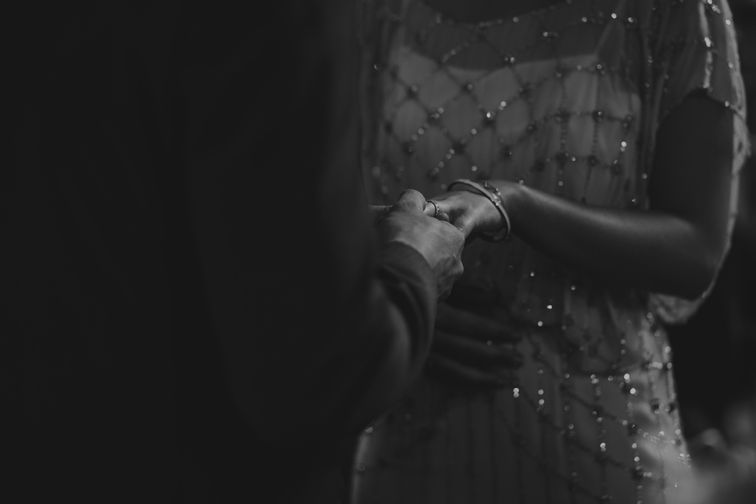
Why not do it all?! It’s your day after all! The sample I included in Step #1 doesn’t include a ring exchange, but you can definitely have a ring exchange along with your handfasting. There are several ways to go about this.
You can do the vows, handfasting, and ring exchange in any order. Just think about if you’d like your hands to be joined as you say your vows, which can be lovely — and also tricky if you’re reading your own vows and need a free hand for the piece of paper!
My personal preference for the ceremony order with the couple having written their own vows AND doing a ring exchange would be something like this:
- Processional
- Welcome & Opening Remarks
- First Reading
- Second Reading
- Presentation of the handfasting cords
- Handfasting ritual/blessing (hands released from cords)
- Vows read
- Rings exchanged
- Declaration of marriage
- Recessional
This way, the couple can do a full figure-eight/infinity symbol hand fasting with both of their hands tied together. And also, they will not have to be bound, their arms getting tired and uncomfortable, while reading their vows. Finally, the ring exchange can come right before the declaration of marriage.
If the couple hasn’t written their own vows AND wants to include a ring exchange, I would keep the ring exchange at the end just as above. But I would just do the repeat-after-me or respond-“i do”-type-of-vows while your hands are still bound in the handfasting.
#6: Watch a Real Scottish Handfasting Take Place Before Your Ceremony
The steps for a handfasting can be as simple or as complicated as you’d like them to be. I would recommend that, unless you’re having a Pagan or Wiccan wedding (which can be quite ritualized and complex), you keep it as simple as possible.
I say this because it’s a lot of moving pieces as it is, and it’s best for the flow of the ceremony that there aren’t too many tiny details to cover.
The steps are defined in Step #1 in the sample script, but it’s very useful to see a real life Scottish handfasting ceremony with the “celebration of hands” recited. With the magic of the internet, this is possible — lucky for us!
In this video, you can see the couple’s officiant lay the knot so that it ends with the couple tying the knot together by simply taking a step back from each other at the end of the ritual:
#7: How to Tie the Handfasting Cords
One of the fun things about handfastings is that there are no rules and you can tie the handfasting cords and ribbons in many different ways.
I really love how the woman in this video shows how you can make an infinity knot on the couple’s hands, and then gives some suggestions for what to do with the cord afterward. She shows the three-cord ceremony, outlined in detail in Step #1’s sample script:
Although the video quality is not quite as nice in this one, the information is great. The woman here shows how many different knots can be tied for a handfasting. She also mentions that there is no one way to hold the hands together, as some couples choose the double-hand infinity symbol and some choose to clasp just one hand. It’s all up to you:
What can go wrong at a handfasting ceremony?
What can go wrong at a handfasting? Really, if you’re prepared and have practiced once or twice with your officiant, you have nothing to worry about. If for whatever reason, the knot tying doesn’t go exactly as planning, or the cords get dropped, it’s not a big deal. Everyone will laugh it off and continue on. It’s important to keep a sense of humor about the whole thing and to remember to have fun.
Run through it several times if you’re nervous and communicate all of your concerns with your officiant so that they can be ironed out before the big day. If you do this, you’ll have nothing to fear.
#8: Is a Handfasting Ceremony a Legal Marriage?
If you want your handfasting ceremony to have legal status, recognizing you as a legal couple in the eyes of the law, matrimonial law differs from state to state, province to province, and country to country– so you will have to check with your local attorney general’s website.
In some places, handfastings officiated by an ordained minister are considered common-law marriages, which in some places, hold the same or similar status to a marriage. It’s hard to give a definitive answer to this, just because it’s so dependent on where you’re having your handfasting ceremony.
One thing couples can always do is just to get a marriage license and have a quick civil ceremony, and then have their beautiful handfasting count as the “real” marriage. After all, who’s to say that a legal piece of paper is more important than a ceremony that takes place among family and friends — why should one be more ‘real’ than another?
#9: History of Handfasting Wedding Ceremonies
Handfasting is associated strong with the Ancient Celts, and derives from Pagan cultures and religions. In these times, people believed that the vows spoken at a wedding contained real magic, and that breaking the oath to bind yourself to another person would cause serious consequences.
The Ancient Celts worshiped Nature, and believed it to be a living female entity. They believed that spirits were everywhere among us and that the world itself was alive. Handfasting ceremonies would take place outside, in a forest grove or under a tree to better commune with nature.
In this ancient tradition, couples were handfasted for “a year and day” and then had the choice of renewing their vows after that time, or of parting ways. This is different from the traditions we tend to adhere to now, in which we couple for life!
Now more and more people are turning back to the ancient ritual of a handfasting wedding ceremony, myself included! We’re recognizing how beautiful and powerful it can be, and I think we appreciate what it symbolizes. Handfasting recognizes the love of the couple, the binding together of their two families, and honors the earth we live on.
#10: Renewing Your Vows with a Handfasting
As I just mentioned, the Ancient Celts used to bind their hands, and promise to be together for “a year and a day” after which they would renew their vows again if they wanted. You may already be married, but want to renew your vows with a handfasting ceremony, which is perfectly fine!
A handfasting ceremony is actually an amazing choice for a vow renewal because you won’t have to do a ring exchange, and so you could take the extra time that you have to make the handfasting a bit longer or more elaborate.
You could also use the same sample script in Step #1 but change the language to be “rejoin” and “renew” instead of “joining together for the first time.”
If you didn’t have a handfasting ceremony in your first wedding, you might ask the officiant to explain why you’re choosing to do it this time around and why it’s important to you.
Sources:
Magickal Weddings: Pagan Handfasting Traditions for Your Sacred Union: Planning & Preparation, Rituals & Blessings, Ceremonial Tools, History & Legality, Vows by Joy Ferguson
Handfasting and Wedding Rituals: Welcoming Hera’s Blessing by Raven Kaldera and Tannin Schwartzstein

